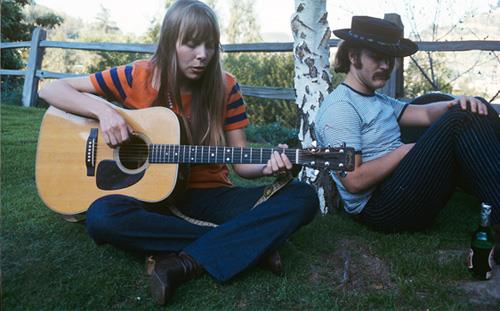
Laurel Canyon, a docuseries on the music from that fondly remembered Los Angeles outpost of yesteryear, hits the right chords.
The two-part docuseries, which airs this Sunday and next 9 p.m. ET on Epix, has the same mellow tone and feeling as much of the music that was associated with The Canyon from the mid-1960s through the mid-1970s.
Director Alison Ellwood tells the story without a running narrator – or rather, with dozens of narrators. She uses the voices of musicians, from David Crosby (top) and Don Henley to Linda Ronstadt and Jackson Browne, to recall the scene and the music behind a continuous backdrop of vintage still photos and film clips.
Some of the commentaries were recorded for this docuseries, and some are archival. It all fits.
The closest thing to a narrative voice is Henry Diltz, the folk musician turned famous music photographer. He was there for the whole scene and photographed everyone in it, so he gets to rhapsodize about the magic. As does another photographer, Nurit Wilde, who wryly recalls that she was considered just a groupie until she landed a paying job at a club.
Laurel Canyon doesn’t aspire to be the definitive docuseries on that whole piece of popular music history about which we have extensive writings. It often feels more like thumbing through a musical scrapbook.
This occasionally leads to some romanticizing, like when David Crosby compares the Laurel Canyon scene to the Italian Renaissance. “Light My Fire” was a great pop radio record in the summer of ’67, but it falls a little short of the Sistine Chapel ceiling.
Ellwood organizes the story in chronological order, and she starts with The Byrds.
Like most of the musicians who would eventually be involved in the Laurel Canyon scene, they came out of folk music. Then they electrified it, moving it to a whole different musical world.
Yet some of the folk flavor and influence never left. Artists like Browne, Ronstadt, and the Eagles never abandoned the quieter side of songwriting, and Ronstadt wasn’t the only one who eventually explored music that went way beyond “folk-rock.”
Ellwood notes that artists didn’t move to Laurel Canyon because it was a musical mecca. They moved there because it was a cheap place to live, with easy access to L.A. and clubs like the Troubadour and Whisky A-Go-Go that would give new artists a shot.
As usually happens, the creative peak came early, when most of the artists were still unknown and following their musical muse wherever it took them. The success of The Byrds placed a light on the far end of the tunnel, and other artists moved toward it, but all in their own ways. Arthur Lee and Love didn’t sound like the Turtles, who didn’t sound like Crosby, Stills, Nash & Young, who didn’t sound like the Doors, who didn’t sound like the Mamas and the Papas.
There was mass intermingling in those early days, the musicians recall, and some of Laurel Canyon’s best moments come in the snapshots from those moments.
Crosby recalls inviting his protégé, an unknown Joni Mitchell (top), to a party arranged by Cass Elliott to welcome Eric Clapton on his first visit to America. Clapton sat mesmerized, Crosby recalls, by Mitchell’s unique guitar-fingering style.
The first part of Laurel Canyon takes the music on its upswing and culminates with an event far from Laurel Canyon: the 1969 Woodstock festival, where Crosby, Stills, Nash & Young (CSNY) made their big-time debut.
Woodstock may seem like an odd place for a Laurel Canyon docuseries to go, but the point seems to be that CSNY’s success there was validation. The Laurel Canyon sound had planted its flag in the center of American popular music.
The second part of the docuseries, while full of interesting music, tracks more of a declining trajectory toward the scene’s eventual dissolution.
The culprit was the usual suspect: success. As artists became more popular, they spent less time in Laurel Canyon and less time with each other. They had relocated into the music industry, whose siren call doesn’t always have the proper warnings.
Laurel Canyon, the docuseries, doesn’t dwell on the more sordid details, like the drugs and feuds, but they’re clearly part of the picture. The exhilaration of the early days has blown away into the Hollywood Hills.
Happily, thanks to the magic of recorded sound, that doesn’t negate or diminish the good times and the good things that the scene produced.
The L.A. sound of the Laurel Canyon era stayed with Bruce Springsteen long enough for him to recently record a whole album in its spirit. The rest of us don’t have to go that far. We can just sit back and enjoy the scrapbook.